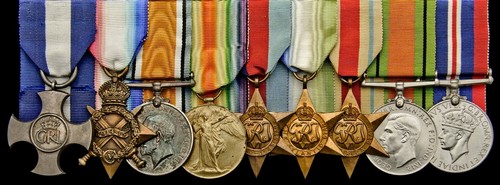
Auction: 14001 - Orders, Decorations, Campaign Medals and Militaria
Lot: 19
The Second War 1942 'Dieppe Raid' D.S.C. Group of Nine to Lieutenant-Commander (E.) A.J. Lee, Royal Navy, For His Gallantry When the Destroyer H.M.S. Brocklesby Grounded on 'White Beach' During the Evacuation Operations, Where Under Point Blank Fire From German Shore Batteries, he Effected Repairs Enabling the Ship to Get Under Way, Thus Saving Her From Certain Loss. A Great War Veteran, Lee Served at Dunkirk, St. Nazaire- For Which He Was Recommended For a D.S.C.- and Dieppe; When He Participated in the Last Two Raids He Was Nearly 50 Years of Age
a) Distinguished Service Cross, G.VI.R., reverse officially dated '1942' (Hallmarks for London 1942)
b) 1914-15 Star (M.1138, A.J. Lee, E.R.A. 4., R.N.)
c) British War and Victory Medals (M.1138 A.J. Lee. E.R.A. 3 R.N.)
d) 1939-1945 Star
e) Atlantic Star
f) Africa Star
g) Defence and War Medals, generally very fine or better, mounted court-style for display (9)
D.S.C. London Gazette 2.10.1942 Lt (E) Albert James Lee, R.N. (Dieppe), H.M.S. Brocklesby
The Recommendation, dated 22.8.1942, states: 'Whilst under heavy fire, showed coolness and skill in effecting repairs to forced lubrication system, thus enabling the ship to get under way again. As the ship was under fire at point blank range from shore batteries, his promptness saved the ship from becoming a total loss.'
Lieutenant-Commander (E.) Albert James Lee, D.S.C. (1893-1970); served with the Royal Navy during the Great War as an Engine Room Artificer, and progressed through the rates being made Warrant Engineer, 1.4.1925; service between the Wars included in the destroyer H.M.S. Tyrant, of which his then commanding officer wrote: 'In every way that I am competent to judge, he is a model engineer officer of a destroyer. I cannot imagine a better one... his opinions are shrewd and well expressed.' (Service Papers refer); commissioned Lieutenant (Engineer), 1.7.1939; served in the destroyer H.M.S. Saladin, July 1938 to June 1940, during which period she took part in the evacuation of allied troops from the beaches of Dunkirk, May 1940, sustaining severe damage from enemy air attacks; later that year Lee transferred to H.M.S. Brocklesby, a 'Hunt' Class Destroyer launched 30.9.1940 and completed 1.4.1941; on completion she joined the 15th Destroyer Flotilla, Plymouth Command.
The St. Nazaire Raid
Brocklesby was employed with convoy escort duties until 1942, when she was tasked to participate in 'The Greatest Raid of All', the St. Nazaire Raid, 27.3.1942: 'The naval forces comprised one motor gunboat as headquarters ship, in which were embarked the Senior naval officer (Commander R.E.D. Ryder) and the military commander (Lieutenant-Colonel A.C. Newman), 16 motor launches (M.L.s), some carrying troops and some armed with torpedoes, and one motor torpedo boat (M.T.B.). The Campbeltown (Lieutenant Commander S.H. Beattie) also carried troops. For the outward passage all the headquarters staff embarked in the destroyer Atherstone. She and her sister ship the Tynedale formed the escort force, while two more 'Hunt' Class destroyers (the Cleveland and the Brocklesby) were to reinforce the expedition for the homeward passage' (The War at Sea, Vol. II, Captain S.W. Roskill, D.S.C., R.N., refers). H.M.S.'s Brockelsby and Cleveland came under heavy and constant air attack whilst assisting in the return of H.M. Motor Torpedo Boat 314, and H.M. Motor Launches 270 and 446 from St. Nazaire. For his gallant conduct during the St. Nazaire raid operations Lee was recommended for the award of an Immediate D.S.C., 9.4.1942.
The Dieppe Raid
Five months later Lee and the Brocklesby were involved in another daring Commando raid, this time on Dieppe, 19.8.1942; as one of eight small destroyers (H.M.S.s Albrighton, Berkeley, Bleasdale, Brocklesby, Calpe, Fernie, Garth and the Polish Destroyer Slazak) she travelled out from Newhaven the night before the raid, taking up a sentinel position on the eastern side of the Jubilee assault fleet. In the early hours of the 19th the raid's supporting destroyers bombarded Dieppe seafront and the two headland positions prior to the first waves on of troops landing at 05.23hrs. As the raid progressed the destroyers continued to engage the larger German gun emplacements and provide what covering fire they could with their 4 inch guns for both the landing craft and the assaulting British Commandos and Canadian troops.
As the raid started to stall, and eventually go from worse to worse with grievous losses being suffered by both the land and sea forces, the withdrawal was ordered, 'The signal to withdraw, the codeword 'Vanquish', went out at 0950hrs when the withdrawal was set for forty minutes later at 1030hrs. This was swiftly amended to 1100hrs... Hughes-Hallett then had to send word to Commander H.V. McClintock, the officer in charge of the boat pool, ordering the landing craft into the beaches for evacuation. Orders also went out to the bombardment destroyers, urging them to shell the German positions on the headlands and reduce their ability to hamper the evacuation. H.M.S. Brocklesby duly shelled the slopes around Pourville, and H.M.S. Garth, though low on 4 inch ammunition, engaged the guns on the eastern headland.' (The Dieppe Raid, R. Neillands refers).
The communication of Hughes-Hallett's order was mis-interpreted by several of his officers and in consequence, 'a considerable number of LCP (L)s.... duly crossed the Channel and were back in Newhaven that evening, without a single soldier on board.' (ibid). This was to prove catastrophic as these small craft were vital for enabling the evacuation of the retreating troops directly from the beaches, 'The premature departure of those landing craft to the UK was now taking effect. There were no more boats to send in and those reaching the beach were in trouble... The scenes on Red and White Beaches during this time were quite terrible, each a larger replica of those taking place at Pourville. Of the four LCAs that made up the first wave into White Beach, all were immediately rushed by troops, one was promptly overturned and then hit by artillery fire, all on board being killed. The other three craft managed to limp out to the destroyers, each carrying some seventy men, about twice the safe number. Another eight LCAs, supposed to land on White Beach, actually arrived on Red, where six were quickly hit by shellfire and destroyed. These were the last craft even to attempt a landing on Red Beach. The two surviving craft got away - one carrying no fewer than eighty men - but were so badly damaged that they sank shortly after delivering their passengers to the destroyers.' (ibid)
Due to the distinct lack of small craft, 'the Royal Navy were doing all they could to support the troops ashore while under air attack from dive-bombers and being shelled from the cliffs. H.M.S. Brocklesby went within 500 yards of the shore off the main Dieppe beach to bombard the headlands and ran briefly aground. H.M.S. Berkeley, also sailing close to the beach, was hit amidships by a bomb which killed a number of the crew and broke the ship's back.' The situation was desperate, and given Brocklesby's proximity to the beach a lot of the troops decided to swim for it. The latter included Royal Marine Richard McConkey of 'A' Commando, 'I swam... we were picked up by H.M.S. Brocklesby, and they gave us dry gear and put us below, but then their Skipper came down and said, 'Can any of you Marines use an Oerlikon anti-aircraft gun?' So my mate Knocker White went up and soon had it blazing away. We got hit six times on the Brocklesby and went aground once, but they stayed to pick up survivors - what guts that Skipper had! We came back to Pompey doing four knots under air attack most of the way!'
The incident when the Brocklesby ran aground to which McConkey refers, was the moment in which Lee saved the destroyer and the lives of all those aboard. His Skipper gives more incite, 'The smoke almost brought disaster to Brocklesby when the destroyer moved into White Beach during the evacuation. "I approached as close as I considered navigationally safe in thick smoke and then turned parallel to the beach', said her Captain, Lieutenant-Commander [Edward] Nigel Pumphrey. "Since I could give no assistance commensurate with the risk to my ship from staying so close inshore I altered to port to open from the shore but as the ship turned her stern grounded. I continued to go ahead and she came off but hits from shells emptied the lubricating oil reserve tank and shot away the lubricating pipes, putting both engines out of action.' As Brocklesby drifted helplessly Lt. Albert Lee saved the ship by repairing the system while under fire, and within three minutes the destroyer was under way again.' (Dieppe 1942 - The Jubilee Disaster, R. Atkin refers).
For this act, carried out under heavy shell and small arms fire, Lee was this time awarded the D.S.C. - the only one given to H.M.S. Brocklesby for the Dieppe Raid. His Skipper received a Bar to his D.S.O. When Brocklesby and her complement finally managed to limp home, it took six weeks to repair the damage done to her during the course of the raid. Lee remained with the Brocklesby until May 1943, when he was placed on the retirement list, being appointed Lieutenant Commander (E) Retd, 1.7.1947. A veteran in all senses of the word, Lee was nearly 50 years of age when he took part in both the St. Nazaire and Dieppe Raids.
Subject to 20% VAT on Buyer’s Premium. For more information please view Terms and Conditions for Buyers.
Estimate
£6,000 to £8,000




